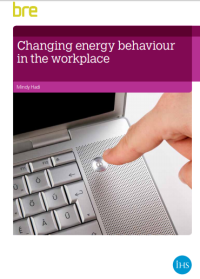Changing energy behaviour in the workplace (FB 73)
BRE (Building Research Establishment) is an independent, research-based consultancy, testing and training organisation, operating in the built environment and associated industries.
Changing energy behaviour in the workplace (FB 73) was written by Mindy Hadi and published by BRE on 16 March 2015.
Companies are becoming more aware of the public relations value of the green agenda. Information on their sustainability performance is being reported on, including in annual corporate responsibility reports.
Energy use is influenced by a variety of factors: physical factors such as the building itself, its services and control systems, and also social factors that govern energy use behaviours, such as lifestyle, individual differences and group composition.
This 20-page guide discusses the impact of energy use in the workplace on both the end-user and the company. It considers the role of feedback as a change mechanism and the use of interfaces such as eco-visualisation to motivate and maintain change, using examples from BRE research.
It is aimed at small and large organisations and corporate occupants who are interested in engaging their staff in saving energy in the workplace.
Its contents are:
- Introduction.
- Energy-saving potential in non-domestic buildings.
- The role of the end-user in energy consumption in the workplace.
- Motivating and influencing behaviour.
- Engaging the end-user in non-domestic buildings.
- Using energy consumption feedback in behaviour change.
- Automated systems - pros and cons.
- Conclusions.
- References.
[edit] Related articles on Designing Buildings
- Battery energy storage systems with grid-connected solar photovoltaics BR 514.
- Battery storage.
- BRE articles on Designing Buildings Wiki.
- BRE Buzz articles on Designing Buildings Wiki.
- BRE Buzz.
- BREEAM.
- BREEAM Reduction of energy use and carbon emissions.
- BREEAM Energy monitoring.
- Building Research Establishment.
- Changing patterns in domestic energy use FB 76.
- Flexible electrical networks for a low carbon future.
- Glossary of electrical terms.
- The Future of Electricity in Domestic Buildings.
Featured articles and news
RTPI leader to become new CIOB Chief Executive Officer
Dr Victoria Hills MRTPI, FICE to take over after Caroline Gumble’s departure.
Social and affordable housing, a long term plan for delivery
The “Delivering a Decade of Renewal for Social and Affordable Housing” strategy sets out future path.
A change to adoptive architecture
Effects of global weather warming on architectural detailing, material choice and human interaction.
The proposed publicly owned and backed subsidiary of Homes England, to facilitate new homes.
How big is the problem and what can we do to mitigate the effects?
Overheating guidance and tools for building designers
A number of cool guides to help with the heat.
The UK's Modern Industrial Strategy: A 10 year plan
Previous consultation criticism, current key elements and general support with some persisting reservations.
Building Safety Regulator reforms
New roles, new staff and a new fast track service pave the way for a single construction regulator.
Architectural Technologist CPDs and Communications
CIAT CPD… and how you can do it!
Cooling centres and cool spaces
Managing extreme heat in cities by directing the public to places for heat stress relief and water sources.
Winter gardens: A brief history and warm variations
Extending the season with glass in different forms and terms.
Restoring Great Yarmouth's Winter Gardens
Transforming one of the least sustainable constructions imaginable.
Construction Skills Mission Board launch sector drive
Newly formed government and industry collaboration set strategy for recruiting an additional 100,000 construction workers a year.
New Architects Code comes into effect in September 2025
ARB Architects Code of Conduct and Practice available with ongoing consultation regarding guidance.
Welsh Skills Body (Medr) launches ambitious plan
The new skills body brings together funding and regulation of tertiary education and research for the devolved nation.
Paul Gandy FCIOB announced as next CIOB President
Former Tilbury Douglas CEO takes helm.
UK Infrastructure: A 10 Year Strategy. In brief with reactions
With the National Infrastructure and Service Transformation Authority (NISTA).
























